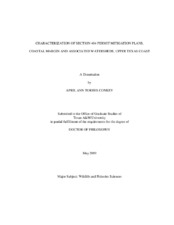| dc.description.abstract | A predicted loss of agricultural rice-wetlands and increasing urbanization and development threatens the remaining freshwater wetlands along the upper Texas coast. To avoid, minimize, and mitigate wetland loss, the U.S. Army Corps of Engineers (Corps) is directed to enforce Section 404 of the Clean Water Act (1975 amendment) by administering permits for development. Furthermore, a 1990 Memorandum of Agreement (MOA) between the Corps and the U.S. Environmental Protection Agency (EPA) proposed a national goal of no net wetland loss (NNL). My goals were to identify the frequency of occurrence of freshwater wetland loss due to dredge or fill, assess final plans to mitigate wetland loss, and verify the persistence of the created compensatory wetlands. I created a database of 96 individual, Section 404 permits issued from 1981 to 2001 in the counties of Chambers, Hardin, Jefferson, Liberty, Montgomery, Orange, and San Jacinto (Galveston District Office, U.S. Army Corps of Engineers). Descriptive statistics were calculated for permit characteristics in relation to issue date (pre- or post-NNL). Public comments received from national and state agencies were rank ordered against mitigation plan type to determine Spearman's Rank Order Correlation Coefficient. Visual identification (via site visits and 1996 aerial photos) was used to validate compensatory wetland persistence. Shoreline protection of private property and oil and gas drilling (64% of permit applicants and 59% of impacts) had the greatest effect on wetland loss in the region, particularly Chambers, Jefferson, and Montgomery counties. Overall, 79.3 ha of freshwater wetlands were gained; however, gain was overestimated due to large projects for habitat enhancement. Permits issued post-NNL were more likely to have formal mitigation plans (58% vs. 13% pre-NNL) and allowed no net wetland loss. Although agency comments recommending more formal mitigation plans increased after NNL, only a weak positive correlation was detected (Spearman's r less than or equal to 0.4). Six of seven created wetlands remained in existence through 2006 though they are freshwater ponds replacing more diverse aquatic systems. I recommend the development of a comprehensive method to track wetland loss, mitigation, and changes in watersheds over time. | en |


